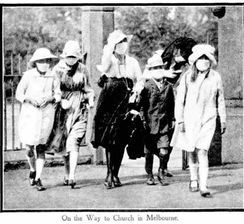
Catholics for Renewal
Subtitle
Editorial, July 2020

Signs of the Times – Leading where?
“There are decades where nothing happens,
and there are weeks where decades happen.”
- Vladimir Ilyich Lenin
The term
'Signs of the Times' appears self-evident. But in the context of Church evolution it
needs to be properly understood to serve its ecclesial intent.
This is particularly so for the forthcoming 5th Australian Plenary Council, a long overdue opportunity to identify, discern and respond to the signs of the times in our era. In the Listening and Dialogue phase of the Council, the bishops asked the Australian faithful to respond to the question: What do you think God is asking of us in Australia at this time? Effectively, the bishops recognised that the Church in Australia is in critical need of renewal and reform.
The Church in Australia is challenged by a significant decline and has become less relevant to both the baptised and the wider community. The response of Christ's faithful to the question posed is therefore immensely important in a dramatically changed environment, and their collective reading of the Signs of the Times was urgent.
The Signs of the times must always be scrutinised by the Church, and history has many examples. In 3rd century Rome, the early Christians recognised that their refusal to worship the Roman gods was leading to their criminalisation. If they were to continue their religious practices with a lesser risk of persecution, they should self-isolate in the catacombs. They did not see this as a permanent solution, but as a temporary means to practicing their faith with less risk.

There is some parallel with the COVID-19 situation of today. During the current lock-down the streamed Mass@Home has replaced community Mass as a means of reducing the risk of infection. It is not a ‘permanent’ solution to a dangerous environment, but a temporary means to allow the faithful to continue to participate online in celebration of the Eucharist and to nourish their faith.
There is already good evidence that it has been helpful. Results of an online survey in a 3 community Melbourne parish reinforces the anecdotal evidence from other parishes, particularly where the Mass@Home has been thoughtfully and collaboratively implemented. Initially, it was feared that Mass@Home might diminish the need for the community-shared Mass. But where it has been supported by good parish online communications and resources, it has resulted in a deeper than anticipated engagement and satisfaction.
While its temporary nature is recognised, Mass@Home has been much appreciated for its intimate personal focus on the liturgy of the Word. For many, the routine sameness of the community Mass has been given an energising and refreshing new feel. Many families have discovered a surprising benefit in sharing the Mass@Home together, some have chosen to stream it from churches and cathedrals whose ambience enriches their experience, and not a few have streamed it in their more familiar first languages.
Of course, most people still yearn for the Eucharistic celebration shared with their parish community. But Mass@Home has suggested some liturgical arrangements which can enhance appreciation of the Word and enrich the spiritual life. These should be further explored.
Catholics for Renewal today publishes the 8th of its Summary Documents in the series designed to contribute a better understanding to some of the key terms and principles to be addressed by the Council. It addresses the 'Signs of the Times'.
With this Newsletter we also publish a detailed analysis by Peter Wilkinson of the inputs of over 200,000 respondents to the Listening and Dialogue phase of the Council. He identifies some key Signs of the Times and issues that the ‘sense of faith’ (sensus fidei) of thousands of Australian Catholics have pointed to needing careful consideration by the Council. Standing out are: greater inclusion of all (the # 1 issue); greater involvement of the laity; remaining faithful to Church teaching; a greater role for women; ending mandatory priestly celibacy and allowing priests to marry; and the ordination of women. Other issues are: putting Gospel values in action; outreach to the wider community; more support for priests; and making the Mass more appealing to youth & children. The analysis document is available HERE.
There have been decades where nothing has happened in the Catholic Church in Australia, when much of the vision of Vatican II was ignored or discarded. In the next two years, there is the hope that decades will happen.
The
"Signs of the Times" Summary document is available HERE.
Other Summary Documents (including Sensus fidei) are available at Document # 93 HERE
Images:
Upper: Signs of the Times, Saatchi Art
Lower: On the way to Church in Melbourne. The Sydney Mail, 12 February 1919, Courtesy Mary Sheeha, The Age 20200724